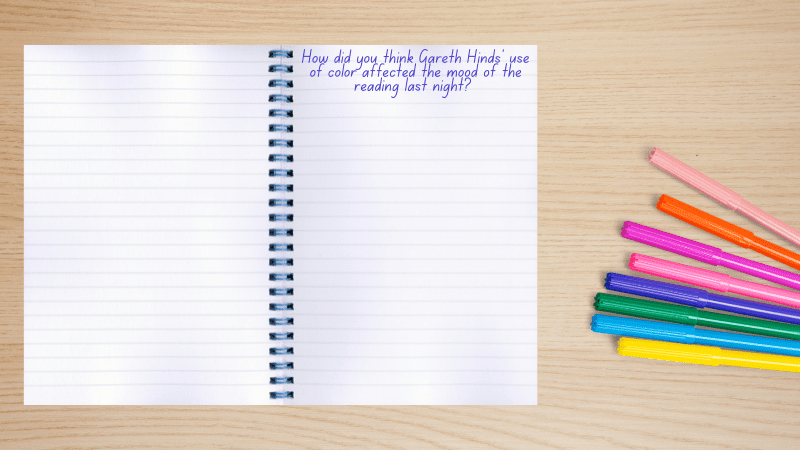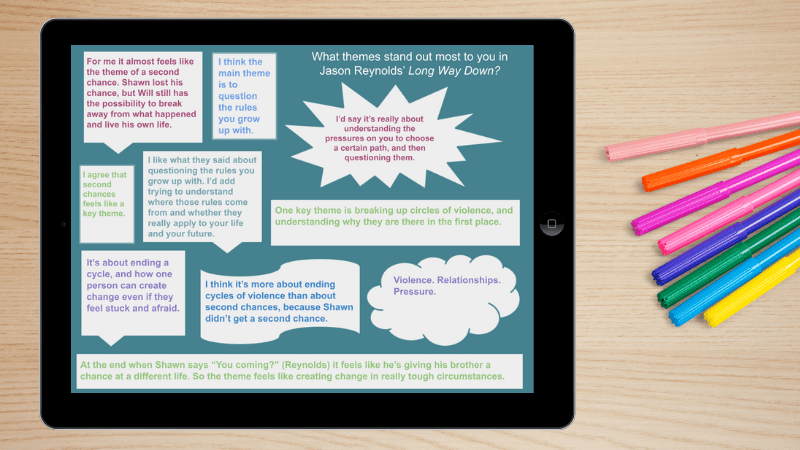You know that feeling when you pull off the perfect discussion in class? Those warm fuzzies on the way to your car as you reminisce about how your dominators took a step back and let others talk, your interrupters stayed on task, and your quieter students got in there and cited textual evidence to prove their point?
It’s not a feeling we get that often.
Discussions are not easy, and with the combination of 30 moods, levels of preparedness, confidence, and everything else, is it any wonder? One of my favorite techniques for holding a discussion that can navigate through all these sticking points is a bit counter-intuitive, but it’s soooo effective. It’s called a silent discussion.
I held my first silent discussion 15 years ago …
It was on a tricky morning in my trailer classroom while trying to wrangle some serious thinking from my students.
“Turn your notebook to a blank page,” I said. “And write a question about the reading at the top.”
So they did.
“Now pass your notebook to the left and write an answer to the question you see.”
Quiet scribbling. Focused concentration. A minute later, I had them pass their notebooks again.
“Read the question and response, then continue the conversation.”
And so on. After 10 minutes, I had everyone pass their notebooks back to the original question writers.
It was magic.
Every single person had the chance to see what others were wondering, see what others were thinking, and write responses of their own. Kids who needed a little extra time to formulate an idea before chipping in verbally had a chance to carefully consider it on the page. My students who usually ignored the discussion wrote down their thoughts instead.
Kids who tended to dominate could write as much as they wanted without talking over anyone else.
I knew I’d struck gold.
A few minutes later, when I asked who wanted to start a conversation with the question they wrote, I had a lot of volunteers. Everyone was warmed up on the topics and ready to dive in to extend what our silent discussion had started.
As you can imagine, that was only the beginning of my silent discussion career. I’ve tried different versions myself and encouraged other teachers to dive in and experiment too.
At this point, I can share a whole menu of silent discussion options, so hang on to your Flair pens and get ready to pick your favorite!
The Notebook Pass

This one’s so simple. Just do what I did that very first time, and have kids write a question and pass it left. And so on.
Butcher Paper Bonanza
Got one of those big notepads? Or giant Post-its? Throw some papers on the wall around your room with key questions on each.
Play gentle music and ask kids to circulate, reading questions, responding to both questions and other responses. Encourage them to add arrows or other connectors to show how their thinking relates to other responses on the paper.
Love sketchnotes? You can encourage sharing visual ideas through icons, doodles, bullets, and sketches too.
Post-It Fun
Short on big paper but rolling in Post-its? Put your key questions on your whiteboard or on table tents in stations around the room, then hand out Post-its to student pairs. They can wander from question to question reading responses and adding their thoughts on their Post-its.
I’ve even used this one while presenting at a teaching conference to give the experienced folks in the room a chance to contribute their ideas to the group:

Google Slides—the Easy, Online Option
Gathering online with your students? Give them group access to a slide deck with questions at the top of each slide and sections for their responses (grab my favorite easy templates here). Invite them to respond to a question, then flip through the slides, reading and responding to others. It’s surprisingly easy to make it work.

Extending a Silent Discussion
When your silent discussion comes to a natural close, you can extend it in a few ways.
You might have students choose one of the topics to explore in writing, now that they’ve read lots of other people’s thoughts.
You might move into a partner or group activity related to the questions.
Or one of my favorites, use the silent discussion as a springboard into a discussion out loud. Because every student has had time to consider questions and write responses, there’s less pressure and more richness and depth as kids begin to talk. Just segue by asking, “Who had a lot of interesting responses to their question? Can you lead us off in conversation by reading your question aloud?”
OK, my friend, are you ready to try it? Don’t be surprised if you feel those fabulous post-discussion warm fuzzies as you head out the door after class.
Looking for more articles like this? Be sure to subscribe to our newsletters!


